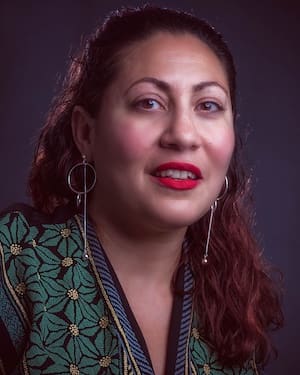The Author Spotlight Series shines a light on writers creating heartfelt and original work across genres, giving them an opportunity to talk about their books and why they do what they do.
Click Here to follow the series as it progresses.
To submit an author for consideration, email editors@myentertainmentworld.ca.
…
“Yannis Lobaina is an award-winning Cuban artist, author, emerging filmmaker, photographer and community arts facilitator based in Toronto. She loves to explore themes of immigration, diaspora, language and motherhood through various storytelling tools. Lobaina believes in the arts as a powering tool for social change and peace-making. She founded and developed bilingual (Spanish-English) creative writing and visual art programs for children worldwide. Read more about her work HERE.”
When did you know you wanted to be a writer?
I have wanted to be a writer since I was about nine years old. From a young age, I was an avid reader. I fell in love with literature and writing fantastic stories and poems.
I didn’t seriously pursue it as a career until my first paycheck at age twenty-six. After a long detour, I am proud that I persevered and achieved my dream career.
Do you remember the first thing you ever wrote?
Yes, I still remember the first poem I wrote and read in public. It was unforgettable. I was in grade 4. My beloved teacher Mirna asked us to write a poem for someone we admire the most. I wrote a poem about my maternal grandmother Ana María and her power to cure diseases with a papaya plant. For me, she had magical abilities! My teacher and classmates have encouraged me since then to keep writing. It was pure joy!
How did you develop your skills?
First, and most important is: being an avid reader from an early age and a very persevering person.
Then, In Cuba, I taught creative writing classes. I studied at the Onelio Jorge Cardoso Literary Training Center, a School for writers, where I graduated in Narrative Techniques. Also, I received several diplomas in complementary courses at the prestigious International Film and TV School in Cuba, like the Creation of Film and TV projects for children and young people, Audiovisual scriptwriting, and sitcom script. Etc.
Another way I develop my skill is when I lead creative writing workshops for multicultural communities around Toronto, with my Bilingual creative writing workshops.
Now, in Toronto, I keep learning. I attended writing conferences, classes, and workshops. I took some creative writing workshops with amazing Canadian authors such as David James Brock, Banoo Zan, Kamal Al- Solaylee, Sheniz Mohamed, Jael Richardson and Hanan Hazime and so on.
Who are some of your biggest literary influences?
It is very hard for me to choose, because I love to read, as I explained before, and I like to be inspired by many disciplines, especially music and visual art. So, I will randomly mention some authors that I brought with me from Cuba.
José Martí , Rainer Maria Rilke,Achy Obejas, Onelio Jorge Cardoso, Anaïs Nin, Guillermo Cabrera Infante, Fina García Marruz, Sandra Cisneros,Reina María Rodriquez, Julio Cortázar, Ray Bradbury, Margaret Atwood, Maya Angelou, Clarice Lispector , Mario Vargas LLosa, etc.
You can enjoy more here: Yannis Lobaina (Author of Finding The Way).
Do you have a favorite book/author?
Momo by Michael Ende.
Paradiso by José Lezama Lima
Invisible Cities by Italo Calvino.
Siddhartha by Hermann Hesse
Rayuela by Julio Cortázar
Borderlands/La Frontera: The New Mestizaby Gloria Anzaldúa
The beautiful and the sad by Yasunari Kawabata
Pedro Páramo by Juan Rulfo.
El núcleo del disturbio by Samanta Schweblin.
How would you describe your work?
Diverse and multifaceted. I had published short stories that navigated this genre: Historical fiction, literary fiction, immigrant stories, family bonds, and fantasy and poetry. I love to explore themes of immigration, diaspora, language and motherhood through various visual storytelling tools.
What’s your writing process like?
My writing process is an analogy. I love handwriting in my notebook Moleskine. Then I transfer to the laptop. Also, I discovered some time ago that writing is a muscle, and that you have to exercise it daily. So, I write every day, sometimes I just doodle, collage and paint and then I flow into the page and do free writing. Just to ebb and flow my mind onto the white page.
After that, I love to have the classic process I studied at school in steps :
Step 1: Prewriting. I spend two or three months upfront researching and brainstorming.
Step 2: Planning and outlining.
Step 3: Write a first draft.
Step 4: Redrafting and revising.
Step 5: Editing and proofreading.
Step 6: Publish or not.
Tell us about your most recent book.
My recent publications have been short stories( Fiction and Nonfiction)and poetry, they are part of my current books.
Barcelona. published in Revista Quimera Número 468 | Diciembre (2022)
Signs in my Path. Published in Anthology by Immigrant Writers
Finding the way by Immigrant Writers Association. (2022)
Flashback issued 9 Portals in Polyglotmagazine. (2022)
Una Noche con Marina Abramovic. Issued in Literary magazine Isliada (2021)
Canadiana Boots. Issued 8 in Tint Journal (2020)
What are you working on now/next?
I’m currently working on three different books. The first is Mapas of my life in Canada (working title)my forthcoming bilingual collection of creative non-fiction stories and photographs. Inspired by my process as an immigrant between Cuba, Halifax, and Toronto.
The second is a picture book dedicated to my daughter Amélie.
The third is a bilingual poetry chapbook accompanied by my landscape photographs from my most recent ongoing series “Alive, Upside Down”.
Before closing, I would love to acknowledge that part of this publication has been possible because I received the Ontario Arts Council’s “Career and Skills Development: Arts Professionals of Color” grant. Without this fund, it would have been difficult for me to dedicate extra time to crafting these stories.
Upcoming events: enlareddeltiempo.com/upcoming-events

